

| |||
By Ron Brothers
I have always been interested in Confederate Flags. I own about 50 replicas of different types. However, the more I study them, the harder it becomes to say, something like "THIS IS THE FLAG OF THE (WHATEVER) REGIMENT."
To a novice civil war buff it would seem easy enough to assume that a regiment fought under a single flag all through the War Between the States. Not so. Some family historians and genealogists want to have a replica of a flag made to hang on their wall and say this is "the Confederate flag my great grandfather fought and died for." Well, I have news for you, you can't say that and be real truthful.
It seems apparent to me that we will go on fruitlessly arguing the causes of the war for centuries to come. One side says one thing, the other side says another. There is one thing for sure, the mind set of the people of the 1860s was as independent and individualistic as any you will ever find. It is difficult and complex to understand and comprehend in today's terms. And . . . they showed this in the banners and flags they carried off to war, because it is hard to find any two alike.
I am deeply involved with the history of Lamar County, Texas as my own Reed ancestors have been here since 1841. Their offspring married into many of the families of the county and I have hundreds of cousins that can trace back to this 1841 arrival. So it would follow that I would be interested in a lot of the men who enlisted in the war from Lamar County. Two of my relations, Hiram Duff and Tilford Reed, were in the 9th Texas Cavalry. So when I found an account of one of them recorded forever in a newly published book it was natural for me to share this account with the rest of the world. So I did, and unbeknownst to me I opened a Pandora's box of controversy over what banner a regiment of more than 1000 men fought under.
If you can get through the maze that follows, you will see there is very serious evidence presented. I have managed to find myself in the middle of all of it. So I have attempted to record all their views, whether I agree or not. I won't say one is right and another is wrong. You will have to be the judge. My attempt to post a new found discovery has turned into a message board of scholarly arguments for one viewpoint or another. Who am I to judge? It appears what I thought at first about the flag has its flaws, so in the interest of truth, and, so no one else will assume something without knowing as much as possible about the subject I relay the following facts and accounts.
I truly hope the respondents of my query about the flag of the 9th Texas Cavalry do not mind me sharing their views. If you have one, send it to me and I'll post it here.
The story begins in an account from Richard Lowe, A Texas Cavalry Officer's Civil War: The Diary and Letters of James C. Bates, (Baton Rouge: Louisiana State University Press, 1999), p. 79.
On March 7, 1862 the 9th Texas Cavalry was at Elkhorn Tavern (Pea Ridge) Arkansas assigned to McIntosh's cavalry in Ben McCulloch's wing of the Confederate Army. As the column was moving near an open field a federal battery surrounded by some 500 union soldiers opened up on the men on horseback and startled this part of the army that was not expecting a skirmish at this time. Three regiments were promptly directed to charge the menacing cannons.
"At the sound of the bugle we began to advance in a walk, then a trot; when we had covered about of the distance, the charge was sounded; our horses were put to full speed and we rushed in among the Federals, our men being armed mostly with double-barreled shot-guns, loaded with buck shot. By reserving our fire until we were among them, then firing both barrels into their ranks, then clubbing our guns, the effect was terrible."
A private in the 9th Texas Cavalry later boasted that his regiment was first to the battery. "The 9th Texas being the nearest to the battery were the first to reach the guns and Company K, the center and guide company of the regiment, was the first to plant a flag on that battery."
Another soldier in the 9th Texas was even more specific: "Our color bearer, Hyram Duff, was the first man to the battery; he jumped upon one of the guns and waved our battle flag over it." Footnote: Private Sparks described the banner as "a small brownish red silk flag, in the center of which was a crescent moon and thirteen five-pointed silver stars. It was trimmed with silk fringe and was attached to a dark mahogany colored staff with a gilded spear head at the top" (Sparks, War Between the States, p. 53).
A likeness of this flag, often called a Van Dorn battle flag, is in Alan K. Sumrall, Battle Flags of Texans in the Confederacy (Austin: Eakin Press, 1995), p. 42.
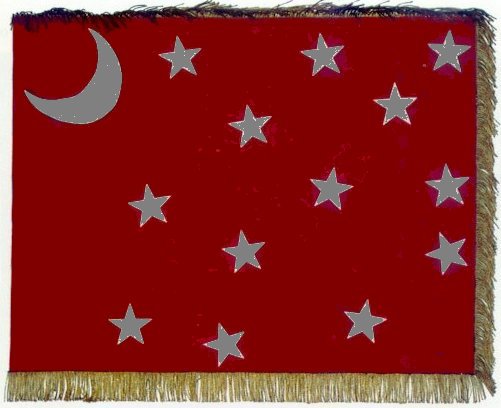 Such a flag is believed to look like this. Though
Sparks stated "in the center was a crescent moon,"
it is not believed he is talking about the actual
symmetrical center of the flag. As no surviving
flags show the moon in such a position. A
"brownish red" as Sparks alluded to, would
suggest a maroon colored background. He also
noted the stars were of silver (not white) as found
in other flags.
Such a flag is believed to look like this. Though
Sparks stated "in the center was a crescent moon,"
it is not believed he is talking about the actual
symmetrical center of the flag. As no surviving
flags show the moon in such a position. A
"brownish red" as Sparks alluded to, would
suggest a maroon colored background. He also
noted the stars were of silver (not white) as found
in other flags.
Alan K. Sumrall, Battle Flags of Texans in the Confederacy, (Austin: Eakin Press, 1995), page 42 describes the dimensions as probably 30 inches x 40 inches.
Howard Michael Madaus, The Battle Flags of the Confederate Army of Tennessee, (Milwaukee: Milwaukee Public Museum, 1976), page 38 notes that the 27th Ohio Volunteers captured the "unmarked Van Dorn pattern battle flag of the 9th Texas Cavalry" in October of 1862 in the battles in and around Corinth, Mississippi.
Unfortunately, there are many flags of this general "Van Dorn" design that have the stars in various arrangements. Madaus shows at least five different star arrangements in his book on page 41 and undoubtedly there were probably more.
 Another picture of this design is found in June E. Tuck,
Civil War Shadows in Hopkins County, Texas, (Sulphur
Springs: Walsworth Publishing Co., 1993), page 389.
This flag was displayed by survivors at a Confederate
Reunion in Cumby, Hopkins County Texas in the early
1900s. The men holding it are identified left to right as
Thomas C. Alexander and Jessie Garrett.
Another picture of this design is found in June E. Tuck,
Civil War Shadows in Hopkins County, Texas, (Sulphur
Springs: Walsworth Publishing Co., 1993), page 389.
This flag was displayed by survivors at a Confederate
Reunion in Cumby, Hopkins County Texas in the early
1900s. The men holding it are identified left to right as
Thomas C. Alexander and Jessie Garrett.
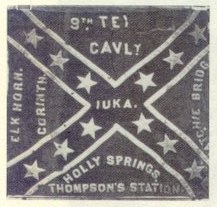 By 1864 the 9th Texas Cavalry is found to be carrying a Richmond
Depot type square battle flag. A surviving picture of it noting the
battle honors of Elk Horn, Corinth, Holly Springs, Iuka, Hatchie
Bridge, Hollie Spings and Thompsons Station is found in June
Tuck's book on page 389. Howard Madaus also notes that this
type flag was carried by L. S. Ross's Brigade that was comprised
of the 3rd, 6th, 9th and 27th Texas Cavalries. All of these units were
former Van Dorn regiments.
By 1864 the 9th Texas Cavalry is found to be carrying a Richmond
Depot type square battle flag. A surviving picture of it noting the
battle honors of Elk Horn, Corinth, Holly Springs, Iuka, Hatchie
Bridge, Hollie Spings and Thompsons Station is found in June
Tuck's book on page 389. Howard Madaus also notes that this
type flag was carried by L. S. Ross's Brigade that was comprised
of the 3rd, 6th, 9th and 27th Texas Cavalries. All of these units were
former Van Dorn regiments.
Confederate Veteran, Volume I, page 178:
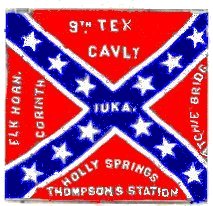 "MRS. BATE'S WANT'S HER FLAG - THE NINTH TEXAS.
"MRS. BATE'S WANT'S HER FLAG - THE NINTH TEXAS.
A friend writes from Arkansas: * * * Thinking you might trace it, here are the story and description of the flag. It was made of dark red bunting, with diagonal cross bars of white with blue stars or blue with white stars, and the names of the battles through which it had been carried - Elkhorn, Iuka, Corinth and some others - were put on in white cloth. It belonged to the 9th Texas cavalry, and was carried by Capt. J. C. Bates' company, and brought off the battlefield by a private in his bosom for Captain Bates, who is now dead. His widow prized the flag above all things. At the time of the reunion at New Orleans Mrs. Bates loaned it to John Webb, who attended the meeting. He was expected to return it to Mrs. Bates at Paris, Texas. He did not bring it back, nor will he tell what he did with it. Mrs. Bates is very much grieved over its loss. Should you be able to hear about it and place Mrs. Bates in position to get it, you would confer a very great favor on her. Information about the flag will be gratefully received at this office."
So the controversy begins....
Haward Madaus wrote:
As far as the flags of the 9th Texas Cavalry are concerned, I am aware of three credited to that unit:
The first of these is an Army of Northern Virginia battle flag-- one of the 12 star silk flags made in
Richmond in October of 1861 and distributed to the Confederate Army of the Potomac in late
November and early December 1861. How the 9th Texas Cavalry ended up with one of these
flags remains an enigma. Perhaps, as we have learned from the Richmond 4th type bunting issue
battle flags that Ector's Brigade received in May of 1864, someone in the 9th Texas Cavalry had
"influence" in Richmond. William L. Cabell, Q.M. of the Army of the Potomac, later recollected
that his wife provided a Virginia battle flag to an Arkansas command (unit not known), so the
possibility is at least there. It is my opinion that this is the battle flag that the 9th Texas Cavalry
carried at Pea Ridge, which was carried into the enemy's
battery. I do not think that the Van Dorn patten flag
was in use at Pea Ridge. The two flags captured during
the engagement are not of that pattern-- one is a blue
silk flag with elements of the Arkansas state motto; the
other was a crude Confederate 1st national flag.
Contrary to my earlier thinking, I am now of the opinion
that the first battle flag of the 9th Texas 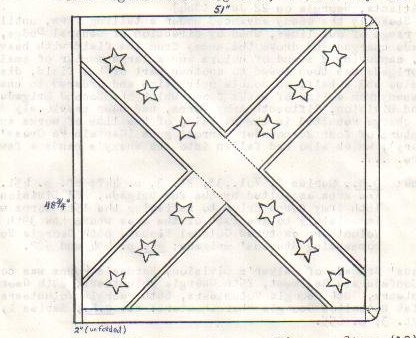 Infantry was
this silk battle flag and it was captured at Corinth,
Mississippi on 4 October 1862 by a member of the 27th Ohio Infantry. This flag was sent to Ohio,
not to the War Department. At any rate, as early as 1887, this is flag was illustrated (complete
with blood stains) as the flag that Orrin B. Gould captured on 4 October 1862. An article later
published in the National Tribute seems to support that identification. Unfortunately, at some
time while in storage, this identity of this flag became confused, and in 1972 it was returned to
Georgia, where it now resides in the State Capitol Museum.
Infantry was
this silk battle flag and it was captured at Corinth,
Mississippi on 4 October 1862 by a member of the 27th Ohio Infantry. This flag was sent to Ohio,
not to the War Department. At any rate, as early as 1887, this is flag was illustrated (complete
with blood stains) as the flag that Orrin B. Gould captured on 4 October 1862. An article later
published in the National Tribute seems to support that identification. Unfortunately, at some
time while in storage, this identity of this flag became confused, and in 1972 it was returned to
Georgia, where it now resides in the State Capitol Museum.
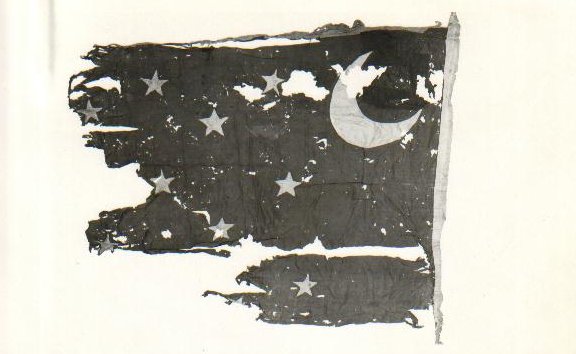 The second flag of the 9th Texas Cavalry was its Van
Dorn pattern battle flag. While Sparks' War Between the
States (p. 53) indicates the design of this flag, it is my
opinion that it was not used by the 9th Texas Cavalry
until later in 1862. Although it is clear that Van Dorn
adopted the special battle flag associated with the "Army
of the West" in February of 1862, after reading about the
campaign and battle of Pea Ridge, I am convinced that
none of the Van Dorn battle flags were anywhere near
ready while the Army was in Arkansas. Recent evidence indicates that at least one of the
Missouri brigades of Price's Division did not receive the Van Dorn battle flag until June of 1862,
and I am leaning to the general issue of the flag to then Van Dorn's Corps of the Army of the
Mississippi about that time. I suspect that the 9th Texas Cavalry received one of the issue flags at
that time but delayed using the flag until after the battle of Corinth (3-4 October 1862). This is
the flag depicted in The Confederate Veteran, Vol. 6, no. 6 (June, 1898), p. 253. This flag still
survives (but somehow it has been associated with Company K of the 9th Texas Cavalry-- was
that company the color company?).
The second flag of the 9th Texas Cavalry was its Van
Dorn pattern battle flag. While Sparks' War Between the
States (p. 53) indicates the design of this flag, it is my
opinion that it was not used by the 9th Texas Cavalry
until later in 1862. Although it is clear that Van Dorn
adopted the special battle flag associated with the "Army
of the West" in February of 1862, after reading about the
campaign and battle of Pea Ridge, I am convinced that
none of the Van Dorn battle flags were anywhere near
ready while the Army was in Arkansas. Recent evidence indicates that at least one of the
Missouri brigades of Price's Division did not receive the Van Dorn battle flag until June of 1862,
and I am leaning to the general issue of the flag to then Van Dorn's Corps of the Army of the
Mississippi about that time. I suspect that the 9th Texas Cavalry received one of the issue flags at
that time but delayed using the flag until after the battle of Corinth (3-4 October 1862). This is
the flag depicted in The Confederate Veteran, Vol. 6, no. 6 (June, 1898), p. 253. This flag still
survives (but somehow it has been associated with Company K of the 9th Texas Cavalry-- was
that company the color company?).
As of 1982, I was informed by Danny Sessums that the flag had been placed by its owners on
display at the Layland Museum in Cleburne, Texas. I was given a photograph of this flag in its
current state, but I have not checked its status in 17 years, and the dimensions that I have are
sketchy. It is my opinion, however, that the flag originally was the same size as those depicted on
pp. 40-41 of my 1976 monograph, The Battle Flags of the Confederate Army of Tennessee. It is
my opinion that the 9th Texas Cavalry carried this flag until October of 1863, when new battle
flags were issued to the brigade.
The third battle flag carried by the 9th Texas Cavalry was
probably issued to the unit as part of a 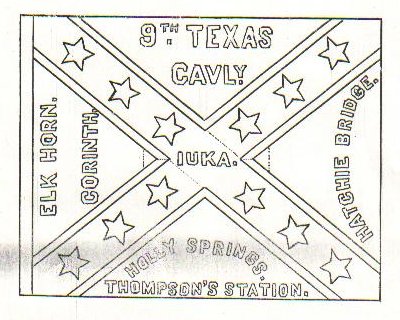 divisional issue of
12 star battle flags made in Mobile, Alabama by Jackson O.
Belknap. On 31 October 1863, Belknap was paid for
several battle flags with honors upon them. After
discussing this with several other flag enthusiasts, I am
convinced that this was the order that resulted in Ross's
Texas cavalry brigade being supplied with new flags. That
of the 3rd was subsequently captured during the Atlanta
campaign. That of the 27th (Whitfield's Legion) was
brought home after the war (and photographed in
Houston), and that of the 9th Texas Cavalry was also saved. I had not seen the records that
indicate that it belonged to Captain J. C. Bates or the snapshot of the battle flag of the 9th Texas
Cavalry that appeared in June Tuck's book (p. 389). This flag survives, or at least it did in 1988,
when a color snapshot of it was loaned to me by a party who knew the owner. The owner then
was living in Tulsa, Oklahoma. I prepared a scale (approximate) drawing based on the snapshot
that I was sent and asked the owner to furnish the actual dimensions. He never responded! I'll try
him again, and maybe I can get him to not only provide the measurements I need on this flag but
also I will ask him to provide a photograph of the flag that you may use on your web-site. I'm not
terribly confident on this, but at least I'll try again.
divisional issue of
12 star battle flags made in Mobile, Alabama by Jackson O.
Belknap. On 31 October 1863, Belknap was paid for
several battle flags with honors upon them. After
discussing this with several other flag enthusiasts, I am
convinced that this was the order that resulted in Ross's
Texas cavalry brigade being supplied with new flags. That
of the 3rd was subsequently captured during the Atlanta
campaign. That of the 27th (Whitfield's Legion) was
brought home after the war (and photographed in
Houston), and that of the 9th Texas Cavalry was also saved. I had not seen the records that
indicate that it belonged to Captain J. C. Bates or the snapshot of the battle flag of the 9th Texas
Cavalry that appeared in June Tuck's book (p. 389). This flag survives, or at least it did in 1988,
when a color snapshot of it was loaned to me by a party who knew the owner. The owner then
was living in Tulsa, Oklahoma. I prepared a scale (approximate) drawing based on the snapshot
that I was sent and asked the owner to furnish the actual dimensions. He never responded! I'll try
him again, and maybe I can get him to not only provide the measurements I need on this flag but
also I will ask him to provide a photograph of the flag that you may use on your web-site. I'm not
terribly confident on this, but at least I'll try again.
Greg Biggs wrote:
A couple things on the flag of the 9th Texas Cavalry (ANV silk):
1) Peter Cozzens writes in his Corinth/Iuka book that it is the flag of the 6th Texas (Dismounted) Cavalry that was lost at Corinth rather than that of the 9th.
I have checked all his footnoted sources, including the book on Fuller's Ohio brigade (to which the 27th OVI belonged) - and all of the sources state that it is the flag of the 9th. Am I not mistaken that the CV article denied that the 9th lost their flag at Corinth? Or - since the article depicted their Van Dorn pattern flag, does it then follow that they used that flag sometime after the silk ANV flag as Howard states in his not?
2) What is the book Sparks "War Between The States" and what does it say about the Van Dorn flags? I am not familiar with this one - and what does it state?
Ron Brothers replied: A. W. Sparks, The War Between the States, as I Saw It, (Longview, TX: D&D Pub., 1987.): Private Sparks described the banner as "a small brownish red silk flag, in the center of which was a crescent moon and thirteen five- pointed silver stars. It was trimmed with silk fringe and was attached to a dark mahogany colored staff with a gilded spear head at the top." Sparks was a private in Co. I, 9th Texas Infantry.
3) What is June Tuck's book that you mentioned?
Ron Brothers replied: June E. Tuck, Civil War Shadows in Hopkins County, Texas, (Sulphur Springs: Walsworth Publishing Co., 1993.) The book is mostly about Hopkins Co. men; includes lists of militia units formed there before they were brought into CSA army; brief biographies and pictures of many CSA vets in the county, a lot of them from the 9th Cavalry; notes from Matt Ashcroft UCV camp.
Howard Madaus wrote 14 Oct 1999:
A comment in relation to Greg Biggs' e-mail-- I checked the reference in Confederate Veteran (Vol. 17, No. 9-- Sept. 1909, p. 455). The denial of the loss of their colors at Corinth was made by John E. Lozedon of the 9th Texas INFANTRY. He suggests instead that the flag in Ohio may have instead belonged to the 9th Texas CAVALRY (then dismounted), and, despite Peter Cuzzins claims in his book on Iuka/Corinth that the flag was that of the 6th Texas Cavalry (dismounted), I find nothing in the contemporaneous documents that indicate any unit other than the 9th Texas Cavalry (dismounted) as the source of the flag captured by Gould. (By the way, in yesterday's letter, I erroneously listed the date of the Confederate Veteran in which the Van Dorn battle flag of the 9th Texas Cavalry appeared as 1896--- it should have been 1898.)
One document that I did not quote in yesterday's letter was the article describing flags that appeared in The National Tribune on 7 February 1889. According to that article, "The large flag has the greatest history. of any we have in the room, but space will not permit me to give it in full at this time. Those dark spots are blood stains, which gives it the name of "The Blood Stained Flag." It belonged to the 9th Tex. and was captured by Orion B. Gould, 27th Ohio, at the battle of corinth. The printed history is from a letter sent to the Gov. Todd by the Colonel of the regiment with the flag. This is what was known as their battle flag; it has red ground with blue cross bars and 12 stars." I am not familiar with the "letter" sent to Governor Todd of Ohio. I presume that it must be in the Ohio state archives. Is anyone close enough to gain access to that potential source?
As to the possible source of Army of Northern Virginia 12 star silk battle flag, in cross referencing Shea & Hess' book, Peae Ridge: Civil War Campaign in the West (pp. 16-19 and 26), I find that General McCulloch, in December of 1861, left for Richmond and did not return until 5 February 1862. As a Texan, he would have been a logical candidate to bring back a silk QM issue flag, but did he have any close association with Sims' 9th Texas Cavalry? (Colonel Young's trip to Richmond in the Spring of 1864 netted all of Ector's Brigade new QM flags, not just the 9th Texas Infantry.)
On a related matter, I mentioned that Major (and subsequent brigadier-general) William L. Cabell, in discussing the origin of the Confederate Army of Northern Virginia battle flag, mentioned that:
"My wife who was in Richmond, made a beautiful flag out of her own dresses (silk), and sent it to a cousin of hers, who commanded an Arkansas regiment. This flag was lost at Elk Horn, but was recaptured by a Missouri division under Gen. Henry Little" (Southern Historical Society Papers, Vol. 31-- 1903-- pp. 68-70) I checked some sources to cross reference this statement. General Cabel's wife's maiden name was Harriet A. Rector, daughter of Elias Rector, and Cabel married her in 1856. (Paul Harvey, Jr. Old Tige: General William L. Cabell, C.S.A. (1970), p. 6) At the battle of Pea Ridge, the 17th Arkansas Infantry was commanded by Colonel Frank A. Rector, who I presume is the cousin referred to. And, the 17th Arkansas Infantry did attack near Elkhorn Tavern on 8 March 1862 with Little's Missouri Division. (Shea & Hess, Pea Ridge: Civil War Campaign in the West, map on p. 237.) I find nothing, however, about the loss and recapture of the flag of the 17th Arkansas Infantry in that engagement. If anyone has supporting documentation on this flag, it will evidence another way the 9th Texas Cavalry may have received its silk Army of Northern Virginia battle flag.
Greg Biggs <Biggsk@aol.com> wrote 14 Oct 1999:
The questions remains - was it the 6th Texas Cavalry or the 9th that lost their colors at Corinth? I have only checked the book on Fuller's Ohio Brigade - but Cozzens other sources include:
National Tribune article by Gilmore on the 63rd Ohio; Daily Toledo Blade, 10/20/1862; Moore's "Civil War In Song And Story"; Charles Smith address to Fuller's veterans at OHS; Frank Gilmore to David Stanley letter, USAMHI.
Greg Biggs wrote 14 Oct 1999:
Howard wrote about the letter from the colonel of the 27th Ohio to Gov. Todd regarding the flag taken at Corinth. I will put that on my "to do" list when I next go to the Ohio Archives. That could have some great information.
Cozzens book states that the 27th OVI was fighting hand to hand with the 6th Texas Cavalry - but they were also hit by the 9th Texas Cavalry at Battery Robinette.
As for the Arkansas regiment with the ANV silk flag - do we know have, then, based on what Howard wrote, the ID for the ANV silk flag in the Arkansas State Capitol Collection? They (and I), have always wondered how an ANV silk got to any other unit besides the 3rd Arkansas (only Arkansas unit in the ANV) - which I don't think was at Centreville, VA when the silk flags were issued. A First National flag (former Henderschott collection) was captured by Union naval forces at one of the batteries along Aquia Creek (if I have the right location) - and he attributes this flag to the 3rd Arkansas.
Whatever happens to our discussions on these flags - we need to present some solid evidence to Georgia as to the proper ID for the flag that Ohio mistakenly sent to them in 1972 as the 1st Confederate Georgia/36th Georgia regiment. The National Tribune article of 1889 describes a different flag for that regiment. And we still have a FN remnant for a flag still marked as the one that Pvt. Gould captured at Corinth - that I have identified as that of the Plenitude Invincibles, CO. I, 23rd Mississippi Infantry, probably captured at Ft. Donelson.
As an aside to the FN flag remnant - the curator at OHS told me last week that their former flags curator, now in the New York collection, still stands on his belief that it is the flag that Gould captured. He has not seen any of the evidence I have unearthed however - just been told about it.
Howard Madaus wrote 14 Oct 1999:
In response to Greg's e-mail of 14 Oct, I have to note that I am strongly of the opinion that the pink silk Army of Northern Virginia 12 star battle flag at the Old State House in Little Rock is NOT the flag mentioned by William L. Cabell in his 1903 article. Rather, I am of the opinion that the flag in Arkansas is that of the 5th North Carolina Infantry, captured at Williamsburg, Virginia on 5 May 1862.
The flag at Little Rock bears the War Department capture no. 21. If you look in the "Register of Captured Flags" under that number, you will see that the historical description matches that of War Department capture no. 80. Both flags are identified to the 30th (25th) Arkansas Infantry captured at Murfreesboro. However, only one flag was captured at Murfreesboro from the 30th/25th Arkansas, and that flag is clearly the flag numbered "80". (This latter flag also shows up in the Brady photographs of the New York Sanitary Fair.) It is my opinion that the War Department, when the registry system was instituted in December of 1863, mixed up the identity of the flag it numbered "21" with the information on the flag numbered "80".
The flag captured at Williamsburg had been displayed at the Chicago Sanitary Fair, while those captured in the west from December of 1862 until November of 1863 (or at least those that were turned in to the War Department) were briefly displayed at the Cincinnati Sanitary Fair. If you recollect our correspondence of last month regarding the flags at the Chicago Fair and their current locations, you may remember that the flags that were at Chicago were numbered in the newly established War Department series in the range of 20 to 30. Hence, I am convinced that the flag that received War Department capture no. 21 on its return from Chicago was actually the battle flag captured at Williamsburg (so described in the 4 November 1863 Chicago Tribune article) but was given the incorrect identification actually recorded properly with no. 80. The descriptions I have located of the flag captured from the 5th North Carolina at Williamsburg indicate that it was a pink battle flag, and we know that it was forwarded up the chain of command from the 5th Wisconsin to McClellan, with Lieutenant George A. Custer bringing it to Army Headquarters. I presume that it was sent to the War Department from there.
Greg Biggs wrote 26 Apr 2000:
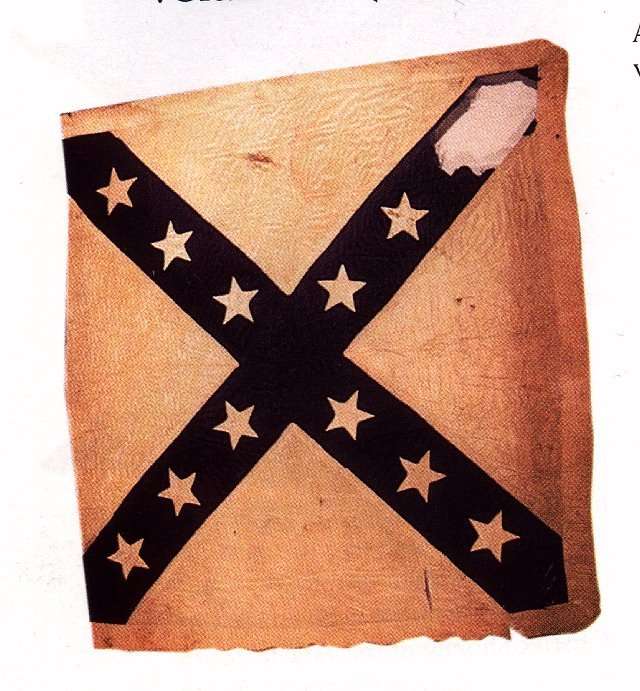 Please note the color picture of the flag of the 9th Texas
Cavalry captured at Corinth, Mississippi by Pvt. Orrin
Gould of the 27th Ohio Infantry, Fuller's Brigade.
Please note the color picture of the flag of the 9th Texas
Cavalry captured at Corinth, Mississippi by Pvt. Orrin
Gould of the 27th Ohio Infantry, Fuller's Brigade.
This flag is currently in the Georgia State Capitol collection in Atlanta and is pictured in the book of their flags collection.
This flag was mistakenly returned to Georgia by the State of Ohio in 1972 when Ohio sent back all of its captured Confederate colors.
The mistake occurred when the flag was improperly identified as the flag of the 36th Georgia Infantry, captured in the Battle Of Atlanta, July 22, 1864.
The 36th Georgia (also known as Villipique's 1st Georgia Confederate Infantry) did lose their battle flag in that engagement. However, as a unit of the Army of Tennessee, it would have carried a rectangular St. Andrews cross battle flag made at the Atlanta Depot in the early Spring of 1864, and issued to the AOT while it was encamped in Dalton, Georgia, just south of Chattanooga, Tennessee.
Indeed, such a rectangular flag is described in an 1889 article of the National Tribune (February 21, 1889 - the forerunner of Stars And Stripes) that featured a tour of the Ohio Relic Room then in the state capitol building in Columbus, Ohio. The flag is described in this article as being "3 by 5 feet" in size - which corresponds to Atlanta Depot battle flags. The flag of the 9th Texas Cavalry is also described in a succeeding article (it ran for four parts) as "the large flag above has the greatest history of any we have in the room, but space will not permit me to give it in full at this time. Those dark spots are blood stains, which gives it the name of the "blood stained flag." It belonged to the 9th Texas, and was captured by Orion (sic) B. Gould, 27th Ohio, at the Battle of Corinth. This is what was known as their battle flag; it has red ground with blue cross bars and 12 stars." (National Tribune, Feb. 7, 1889)
The flag here is an Army of Northern Virginia, Silk Type battle flag first issued in late November, 1861. How a flag of this pattern made it to the Western Theater is still a mystery - but other ANV flags of various issues are documented as having been issued to Western Units. Gen. Earl Van Dorn, commander of the Army of the West, to which the 9th Texas Cavalry belonged, received one of the three "prototype" ANV silk flags from the Cary cousins of Richmond/Baltimore in late 1861. Van Dorn was transferred West in early 1862 and brought his flag with him - and perhaps a handful of the silk ANV flags as well. 120 of these flags were made
according to CS quartermaster Colin M. Selph in a post-war article. The ANV of the time (then called the Army of the Potomac) under Gen. Jospeh Johnston, did not have that many regiments, so if Selph's number is accurate, there were indeed flags to spare.
This flag has faded to a cream color, which is typical of the silk flags of this pattern. It was originally a pink or rose color when it was first issued and virtually all of the flags of this pattern have faded.
If you look closely at the botton quadrant you will see a stained area (more pronounced in the original photo). As this flag has not been conserved, a sample analysis has yet to be undertaken to see if this is indeed blood.
Pvt. Selph was shot by a CS officer of the 9th Texas Cavalry while grabbing for the flag, and it is his blood that stains it.
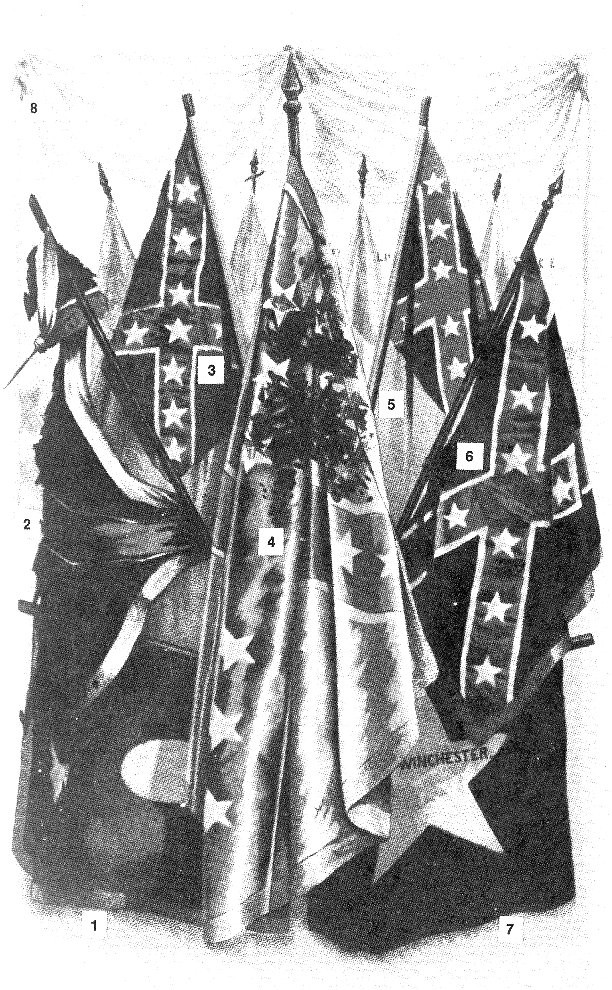 This picture is a drawing based from a display of
these flags in the War Department that was
published in the book "My Story Of The War" by
Mary Livermore, originally published in 1889. The
plates in the original edition were in color - the
plate used for this email is in black & white as that
is how the reprinted edition has them.
This picture is a drawing based from a display of
these flags in the War Department that was
published in the book "My Story Of The War" by
Mary Livermore, originally published in 1889. The
plates in the original edition were in color - the
plate used for this email is in black & white as that
is how the reprinted edition has them.
The flags are picture on Page 421 - and the flag of the 9th Texas Cavalry is marked #4. You can make out the blood stains in the upper right.
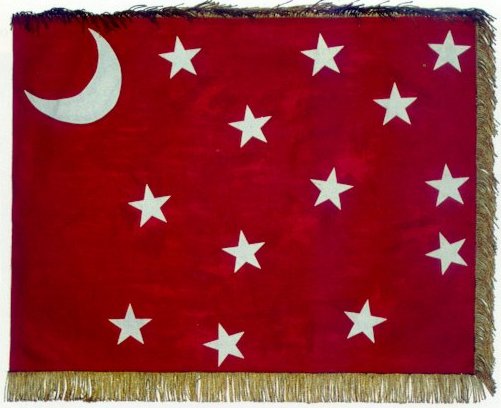 The use of the "red flag with crescent" at Pea Ridge should be
challenged. While Gen. Van Dorn's letter to Gen. Sterling Price about
adopting the Van Dorn battle flags is dated February, 1862, the earliest
evidence we have for them being issued is June, 1862 and only to the
Missouri Brigade at that time. These flags, with fringe, were made by
the ladies of Guntown, Mississippi. The rest of the Van Dorn flags get
issued starting in September. These are the flags with the white or
yellow borders and the 3-2-3-2-3 start arrangements. These were also
probably made in Mississippi. The QM requisition of the 3rd Arkansas Cavalry is the primary
source we have for this - which means that Phifer's Brigade probably received their Van Dorn
flags at this time as well.
The use of the "red flag with crescent" at Pea Ridge should be
challenged. While Gen. Van Dorn's letter to Gen. Sterling Price about
adopting the Van Dorn battle flags is dated February, 1862, the earliest
evidence we have for them being issued is June, 1862 and only to the
Missouri Brigade at that time. These flags, with fringe, were made by
the ladies of Guntown, Mississippi. The rest of the Van Dorn flags get
issued starting in September. These are the flags with the white or
yellow borders and the 3-2-3-2-3 start arrangements. These were also
probably made in Mississippi. The QM requisition of the 3rd Arkansas Cavalry is the primary
source we have for this - which means that Phifer's Brigade probably received their Van Dorn
flags at this time as well.
Another thing - the crescent of the Van Dorn flags is an old Missouri symbol (like the crescent in South Carolina), so why a Texas unit would have received one before the Missouri troops did is still a puzzle to me. Price was also a Missourian and the flag was designed to get Missourians to rally to the Confederate cause, since it was such a swing state.
The other thing is why would the 9th Texas Cavalry use an ANV Silk Issue battle flag at Corinth when they should have received their Van Dorn in September. Two things are possible:
1) They used two flags at Corinth (which did happen sometimes - see 1st Texas Infantry at Sharpsburg), or;
2) They only used their ANV silk flag and when that was lost then used their Van Dorn flag. The only problem with this is the account of the flag after Corinth being shot up pretty well. The surviving Van Dorn flag for the 9th Texas Cavalry is pretty tattered - so I am leaning towards the former theory.
I think the account in Sparks about the red flag at Pea Ridge is hyperbole - unless I can find some other primary source documentation for its use by the Texas company.
Bob Maberry, Jr. wrote 27 Apr 2000
Thank you Greg for sharing the photograph. For the benefit of Ms. Crabb, however, I would like to reiterate, that I still do not believe, no matter what the Yankee report maintains, that a Texas regiment lost a flag at Corinth. Ms. Crabb knows the sources very well, and I am sure she can back me up on this. There are letters, dairies, reminiscences and memoirs (not to mention the OR) by Confederate Texans who participated in the action, and not one mention of a flag captured. In fact the flags of the 6th and 9th Texas are all accounted for! Greg you are a brilliant researcher but I have got to accept what the people that were there tell me.
Greg Biggs wrote 27 Apr 2000:
To respond to Bob Maberry who wrote: "There are letters, dairies, reminiscences and memoirs (not to mention the OR) by Confederate Texans who participated in the action, and not one mention of a flag captured. In fact the flags of the 6th and 9th Texas are all accounted for!"
The problem with Confederate reports of the time frame, is that they RARELY mentioned the loss of colors in a battle. Howard Madaus told me that it was not until sometime in either late 1862 or early 1863 that the CS War Department ORDERED unit commanders to start reporting the loss of colors in their after-action reports! Even still, we can go through the OR's for Gettysburg, for example, and read the regimental reports from Confederate unit commanders who we know definitely lost their flags in that battle (over 50!) and you will still not find that many lost flags mentioned in battle reports! Nor in diaries or post-war accounts!
I am sure we have all learned to take reports and eyewitness accounts of the Civil War from the time period much more seriously than the long after the shooting stopped reminiscences. With such things, often the man writing the reminiscence was not in a position to see if his unit lost a flag - and then even if he found out about it later on - the shame of losing one's colors was still something that did not get mentioned (as in the after-action battle reports by the unit commander).
So, in light of the paucity of flag loss reports from the Confederate side, you have to go to the Union side and see what they state in their after-action reports. And by the way, the Yankees did the same thing - not write too much about losing colors - you have to read the CS reports to figure these out!
The voluminous items I have poured over from the Ohio perspective states quite clearly that the 27th Ohio captured the flag of the 9th Texas Cavalry at Corinth. I will detail my reasons for believing the Buckeyes (and it has nothing to do with the fact that I live in Ohio - I'm from Georgia!!)
1) All of the after-action reports and on-time accounts state uniformly the same thing as to what flag was captured.
2) The history of Fuller's Ohio Brigade (of which the 27th was part) corroborates this in several accounts that are also uniformly the same thing. The book's author was an officer of the brigade and was at Corinth. Also, the newspaper account of the Toledo Blade of late October contains an account of the flag's capture.
3) The only troops that Fuller's Ohioans fought at Corinth were the 6th and 9th Texas Cavalry regiments. The follow-up Arkansas troops sideslipped the fight between Phifer's CS brigade and Fuller's Ohio Brigade and went on to drive off a Minnesota regiment and then drive into downtown Corinth itself. Their advance was finally stopped by a Federal counterattack at the Tishomingo Hotel. The rest of the Confederate assault in the Battery Robinette area was to Fuller's left and engaged other Federal units (this is where the famous assault of the 2nd Texas Infantry took place.)
4) Just to check the possibility of the flag belonging to another unit I also looked into the fates of the 2nd Texas Infantry and the 42nd Alabama flags in the same assault. Both were brought off the field safely - and this was corroborated by at least two accounts for each flag.
5) Not only did the 27th Ohio capture the flag of the 9th Texas Cavalry, but they also grabbed a few prisoners including members of the color guard. Thus, it would be quite easy to figure out what flag was captured by asking one of the men "what unit are you with?" Fuller's after-action report in the OR's is quite succinct as to which units advanced on his position and this report matches others of the Ohio brigade as well as the narrative in Peter Cozzens' book on Corinth.
6) Speaking of Cozzens, his narrative calls the lost flag that of the 6th Texas Cavalry. I have checked all of his footnoted primary sources (save the article in the National Tribune) and they all state it as the flag of the 9th Texas Cavalry. I am now inclined to call it a "typo" in his book and that he meant to ID the flag as that of the 9th.
A.W. Sparks' book mentions that the flag of the 6th Texas Cavalry was lost at Hatchie Bridge, the day after Corinth. This loss is corroborated in the OR by the report of a Federal artillery battery commander whose fire forced the 6th Texas to abandon their colors on the west side of the river and fall back to safety across the small bridge.
7) Finally, in the 1889 National Tribune article that covers the CS relics in the capitol then on display to the public, all of the flags captured by Ohio troops in the war that were sent to Ohio's governor are listed in the article. I have matched this listing up with the accession book of the Ohio Historical Society and the article descriptions and accessions match (except one - OHS has a Mexican War era Georgia flag that was capturred on Sherman's March To The Sea - but this flag was actually sent to Marietta College, who then placed it at OHS for safe keeping.)
All of these flags were returned to their respective states in 1972. Two flags, however, are missing as to their current locations - the "3 by 5" flag of the 1st Georgia Confederate/36th Georgia Infantry, and a gunboat flag taken at Memphis. All the other flags match up exactly between the article in the NT and the accession books of OHS. That means the flag of the 9th Texas Cavalry was in Ohio and was mistakenly sent to Georgia in 1972 as the flag of the 1st Georgia Confederate. The recent book of Georgia's flags states that the ID of this flag as being from Georgia is very tenuous.
What started me on this hunt was the remnant of a silk First National flag that is still at OHS that did not make the return. The paper it is wrapped in states "flag of the 9th Texas Cavalry captured at Corinth by Pvt. Orrin Gould, 27th Ohio Infantry."
I was aware of the flag in Georgia having a shaky ID and I was aware of the descriptions of the flag taken by the 27th Ohio. The flag still at OHS I have identified as that of the Plentitude Invincibles, a company of the 23rd Mississippi, and it was most likely captured at Ft. Donelson, where the 23rd Mississippi served. That regiment also lost a couple other company level flags there. The remains of this flag match perfectly the vivid description of the 1889 National Tribune article (although they called it a South Carolian unit flag - there is no SC unit with that nickname - but there is for the 23rd Mississippi).
So - it came down to "what flag went to Georgia in 1972?" And this is what I have come up with so far. The gist of my research is to:
A) properly identify the flag in Georgia, and;
B) If I have proven my case beyond all doubt, then there is a good likelihood that Georgia would deaccession this flag and send it home to Texas. I have already spoken to the state museum director about this and she would do so if I can concretely ID the flag. So - you Texas guys want a flag or what?? (grin)
And finally, Bob writes: "Greg you are a brilliant researcher, but I have got to accept what the people that were there tell me."
I too have to accept the words of those that were there - the men of Fuller's Ohio Brigade, who, being the typical victors of a battle, were all too willing to sing like a canary about the flag they captured and who it came from. That, as we know, went both ways during the war.